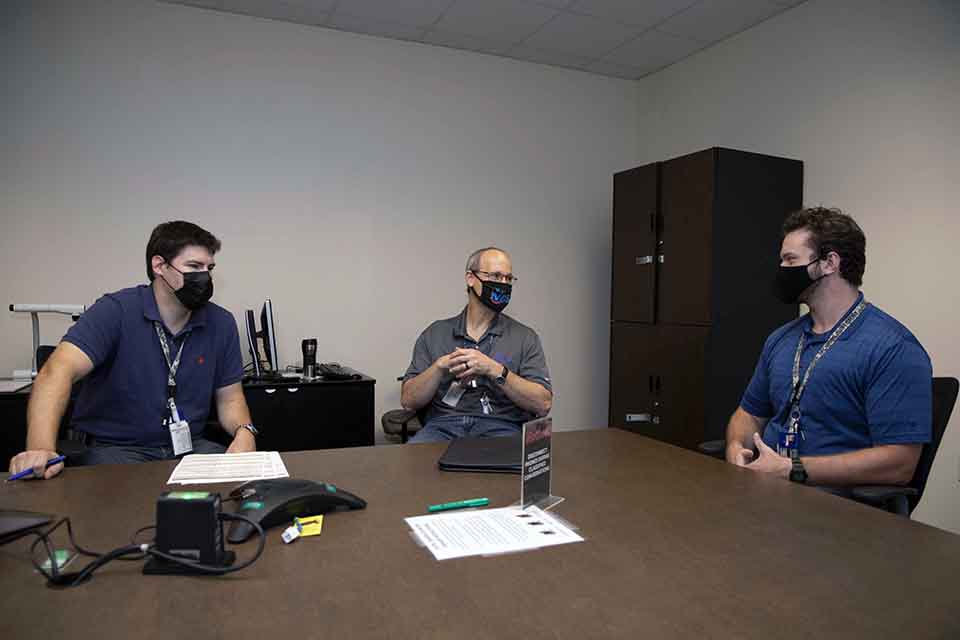
Joshua Schwartz (left), Chris Haught (center), and Dallas Moser discuss maintaining strict controls to ensure nuclear criticality safety.
Anyone who works around special nuclear material at Pantex or Y-12 is aware of the enormous energy release possible from these materials. There are few things certain in life, but for CNS, maintaining strict controls on nuclear criticality safety is one. While the material forms at Y-12 present greater risks, both plants deal with quantities of nuclear material sufficient to warrant consideration for prevention of an inadvertent criticality.
“Y-12 suffered a criticality accident in the late 50s. As a result, many of today’s Y-12 and industry standard NCS program elements grew from lessons learned from that event,” said Ken Keith, deputy vice president of Mission Engineering. “We never, ever want to even approach a repeat event.”
Nuclear Criticality Safety is a collection of programs and activities that help ensure we do not repeat that event, and it requires constant vigilance. An inadvertent or uncontrolled release of energy in the form of radiation and heat is a criticality. To give you a sense of the hazard, only 700 g of 235U has the potential for criticality under the right conditions.
“The unique properties of uranium can create the energy to power reactors and weapons,” said Gary Sanders, CNS vice president of Mission Engineering. “But it requires special controls to both shield our workers from the radiation effects and prevent a cascading reaction.”
Chief NCS Engineer Chris Haught added, “The challenge we face with this hazard is when conditions are unsafe and approaching very near to a critical configuration, there are no warning signs. Because of this, the criticality hazard is non-intuitive and presents unique challenges for ensuring personnel safety. We understand fire hazards, or hazards around pressurized fluids or electricity through normal life experiences, but the criticality hazard must be learned through training and actual operating experience.”
That experience has led to constant monitoring, adjustment, and improvement.
Unanticipated changes in processing activities at CNS over the past couple of years challenged engineers and operations staff to better understand the processes, the assumptions for actions and material flow, and the why of why we care about what we do. CNS has reviewed the way it does business from top to bottom.
“We’ve improved several review and oversight functions, hired additional staff in several areas, improved lines of responsibility, improved training of operations staff, and improved administrative processes,” Keith said.
“We have further strengthened our Nuclear Criticality Safety Program with a dedicated leadership position and integrated and resourced a plan to address the legacy issues to ensure safety of operations,” said Sanders.
That dedicated leadership position is filled by Susan Kozemko, senior director of Criticality Safety Management & Integration. She manages a multidiscipline team that implements criticality safety requirements in a formal and disciplined manner. She also serves as chair of the Nuclear Criticality Safety Committee that is accountable to the site managers and provides oversight and guidance for the NCS program at Pantex, Y-12, and the Uranium Processing Facility.
“Vigilance is required in everything I do to ensure errors are corrected in a timely manner, actions are taken to prevent recurrence, NCS requirements are met, and improvements are proactively evaluated,” Kozemko said.
The work of NCS engineers is never over; it is a constant environment of review, adjust, and improve.
Keith summarized, “While many improvement efforts continue, much has been accomplished and more is to be done.”